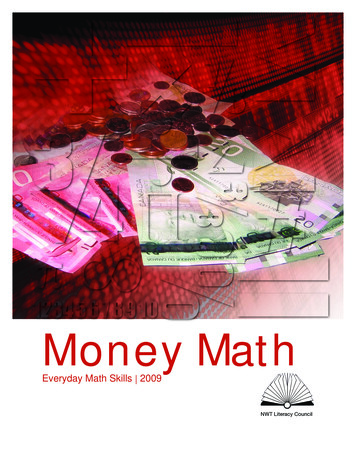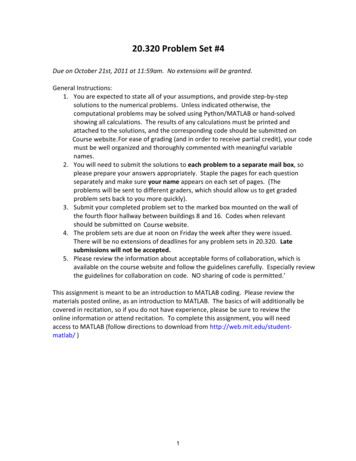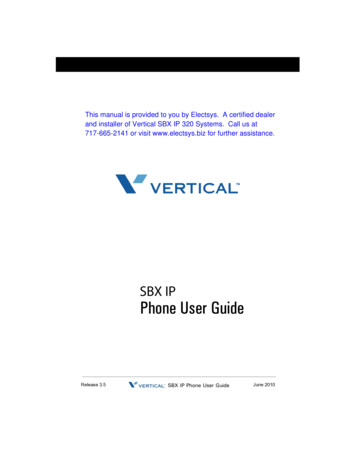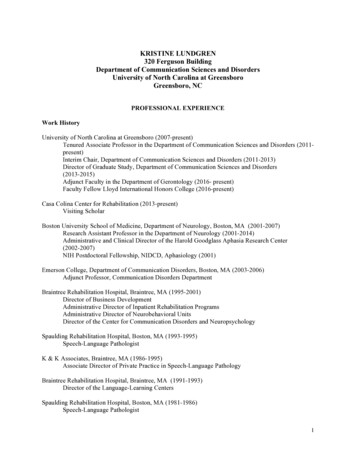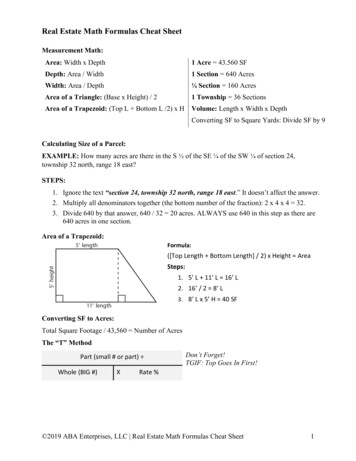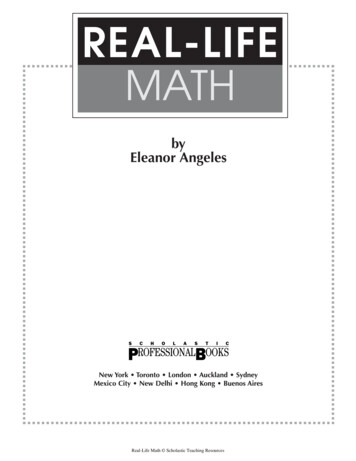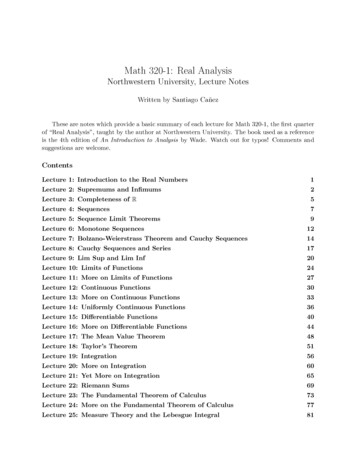
Transcription
Math 320-1: Real AnalysisNorthwestern University, Lecture NotesWritten by Santiago CañezThese are notes which provide a basic summary of each lecture for Math 320-1, the first quarterof “Real Analysis”, taught by the author at Northwestern University. The book used as a referenceis the 4th edition of An Introduction to Analysis by Wade. Watch out for typos! Comments andsuggestions are welcome.ContentsLecture 1: Introduction to the Real Numbers1Lecture 2: Supremums and Infimums2Lecture 3: Completeness of R5Lecture 4: Sequences7Lecture 5: Sequence Limit Theorems9Lecture 6: Monotone Sequences12Lecture 7: Bolzano-Weierstrass Theorem and Cauchy Sequences14Lecture 8: Cauchy Sequences and Series17Lecture 9: Lim Sup and Lim Inf20Lecture 10: Limits of Functions24Lecture 11: More on Limits of Functions27Lecture 12: Continuous Functions30Lecture 13: More on Continuous Functions33Lecture 14: Uniformly Continuous Functions36Lecture 15: Differentiable Functions40Lecture 16: More on Differentiable Functions44Lecture 17: The Mean Value Theorem48Lecture 18: Taylor’s Theorem51Lecture 19: Integration56Lecture 20: More on Integration60Lecture 21: Yet More on Integration65Lecture 22: Riemann Sums69Lecture 23: The Fundamental Theorem of Calculus73Lecture 24: More on the Fundamental Theorem of Calculus77Lecture 25: Measure Theory and the Lebesgue Integral81
Lecture 1: Introduction to the Real NumbersToday I gave a brief introduction to some concepts we’ll be looking at this quarter, such as continuous functions and compact sets. Note that the book does not use the term “compact” until later onwhen it is looking at higher-dimensional spaces like R2 and R3 ; this is something you would studymore closely in Math 320-2 but I think it is important to understand this concept this quarter aswell. I will point out what results in the earlier chapters are really about compactness as we go on,even though the book won’t phrase these results in the same way.Facts about absolute values. For 0, the inequality x a means that the distance (ona number line) between x and a is less than . This can be rephrased as x a .Adding a to both sides, this is the same asa x a .Finally, this in turn means that x is in the open interval from a to a :x (a , a ).It will be incredibly useful to become comfortable manipulating inequalities involving absolutevalues in this manner.Triangle Inequality. ***FINISH***Archimedean Property of R. The Archimedean Property of R says: for any x R, there existsN N such that x N . In words, given any real number we can find a positive integer largerthan it. This is given as Theorem 1.16 in the book, although it is phrased in a slightly differentmanner. I’ll leave it to you to understand why both versions are actually saying the same thing.Proposition. For any 0, there exists N N such that N1 . In words, given any positivereal number (no matter how small), there is a positive fraction of the form N1 , where N is a positiveinteger, which is smaller than it.Proof. Since 0, 1 is a real number. By the Archimedean Property of R, there exists N Rsuch that 1 N . Since and N are both positive, multiplying by and dividing by N does notchange the direction of the inequality, so we get N1 as desired.This is the version of the Archimedean Property which will be most useful for us, and says thatfractions of the form N1 can be made arbitrarily small.Theorem. Given x, y R with x y, there exists ab Q such that x ab y. In words, givenany two numbers (no matter how close they are to each other) we can always find a rational numberstrictly between them. This is what it means to say that Q is “dense” in R. This is Theorem 1.18in the book, although we give a different proof.Proof. Since x y, y x is positive sob N such that1y xis real. By the Archimedean Property, there exists1 b.y x2
Since y x 0, this implies that1 b(y x), so 1 by bx.Since the distance between by and bx is greater than 1, there must be an integer between them sothere exists a Z such thatbx a by.Since b is positive, this givesx a ybas desired.Lecture 2: Supremums and InfimumsToday we spoke about the notion of the “supremum” of a set. This will be an important conceptwhich we will use throughout the course. We didn’t get to defining “infimum” yet, but we’llcontinue with this on Monday. You can find notes I wrote a few years ago on this topic by goingto http://math.northwestern.edu/ scanez/archives/real-analysis/notes.php.Warm-Up. Show that if 3 x 2, then x2 x 6 6 x 2 .The key realization here is that the first absolute value factors as x 3 x 2 . So if we wantthis to be x 2 , it is enough to show that the x 3 term is 6. One way to do this is byadding 3 throughout the given inequality 3 x 2, but we do it a different way here. Note that x 3 6 means the same thing as 6 x 3 6,which means the same thing as 9 x 3. So as long as this string of inequalities is true, so willthe one we want. Luckily, our given restrictions on x do imply this string of inequalities, so we aregood to go.Proof. Since 3 x 2, it is certainly true that 9 x 3. Adding 3 throughout gives 6 x 3 6, so x 3 6. Thus x2 x 6 x 3 x 2 6 x 2 as claimed.Definitions. Suppose that S R is a nonempty set of real numbers. An upper bound of S is areal number u such that s u for all s S. We say that S is bounded above if it has an upperbound. When S is bounded above, the supremum of S is its “least upper bound”. To be precise,b is the supremum of S when it satisfies the conditions: (i) b is an upper bound of S, and (ii) forany other upper bound u of S, b u. We use the notation b sup S for supremums.Remark. We referred above to “the” supremum of S, without actually justifying the fact that ifa set has a supremum, it has only one. This is proved in the book, and we will mention it in classon Monday. Example 1. We claim that the supremum of {x R x2 2} is 2. First, note that aftertakingsquare roots of the inequalitydefining this set, we see that this set is just the closed interval [ 2, 2]. To show that 2 is indeed the supremum of this, we must show that it is an upper3
bound and that it is smaller than any other upper bound. First, any x [ 2, 2] certainlysatisfies x 2 simply due to the definition of closed intervals. Thus 2 is an upper bound forthis set. To show that 2 is the least upper bound, suppose that u is another upper bound for [ 2, 2].Then s u for any s [ 2, 2]. But in particular, 2 itself is in [ 2, 2] so u, being an upper bound, is larger than or equalto it: 2 u. This shows that 2 is an upper bound of [ 2, 2] which is any other upperbound, so it is the supremum as claimed.Alternate characterization of supremums. An upper bound b of S R is the supremum ofS if and only if for any 0, there exists s S such that b s.The condition after the “if and only if” is a precise way of saying that nothing smaller than bcan possibly be an upper bound of S: as varies through all positive numbers, b varies throughall possible numbers smaller than b, and no such number can be an upper bound of S since we canalways find something in S larger than it. Since b is an upper bound of S with the property thatnothing smaller than it can be an upper bound, b must be the least upper bound as claimed. Example 2. We claim that the supremum of the open interval ( 2, 2) is also 2. This shouldhopefully be intuitively clear, but proving it is a little different than we did above for the closedinterval. The difference is that in this case, the claimed supremum is no longer in the set in question,so the argument we gave before will no longer work. (Make sure you understand why not.)Instead we use the alternate characterization of supremums given above. First, again it shouldbe simple enough to see that 2 is an upper bound of ( 2, 2).smaller To show that nothing can be an upper bound,let 0.Ourgoalistofindsomes ( 2,2)suchthat2 s. If you draw a picture of 2 and 2 on a number line, all we need is some number between; their midpoint, which is explicitly given by 2 2 , works. This should be the number in ( 2, 2) which is larger than 2 , showing that 2 cannot be an upper bound.There is one slight issue with this, in that if is too large then 2 2 won’t actually be in ( 2, 2). In particular, this happens if 4 2 since in this case 2 2 2 2 2.2 We get around this by restricting our values of to those which are 4 2. We’ll see why this isenough in the proof below. Proof of claimedAnything in ( 2, 2) is stricly less than 2, so 2 is an upper supremum. bound for ( 2, 2). Now, let 0 4 2. Then 2 2 2 2 2 22 so s 2 2 is in ( 2, 2). This s also satisfies 2 s so for 0 4 2 we have found . For an element of ( 2, 2) which is larger than 2 4 2, 0 is an element of ( 2, 2) which is larger than 2 since in this case 2 isnegative. Thus, this shows that for any 0, 2 is not an upper bound of ( 2, 2), so 2is the least upper bound as claimed.4
Example 3. We claim that the supremumof ( 2, 2) Q is also 2. Here, our set consists only of the rational numbers between 2 and 2. We use the same idea as above, only now thatthe choice s 2 2 no longer necessarily works since this might not be rational, as we need itto be in order to be in the set in question. We are saved this time by the fact that Q is dense in R,which says that for any 0 we can for sure find a rational s such that 2 s 2. There is the same issue as above that we have to be careful if 4 2, but the same way we gotaround that before works here. I’ll leave it to you to write out a precise proof, mimicking the onefor ( 2, 2). nExample 4. Denote the set n 1 n N by A. We claim that sup A 1, which we can guessbased on the fact that the fractions above appear to be getting closer and closer to 1 as we plug inlarger and larger values of n, or by considering the limit of the given expression as n . (We’lltalk about the relation between limits and supremums soon enough.)All fractions we are looking at are positive and the numerator is always smaller than thedenominator, so all such fractions are certainly smaller than 1. To show that 1 is the least uppernbound, again take 0. We want a number of the form n 1such that1 n.n 1Moving some terms around, we can rewrite this as1 n1 , or .n 1n 1This last expression just comes from writing the left-hand side as a single fraction. Again, we arelooking for a value n which makes this true, but now we see that the Archimedean Property of Rprecisely says that we can find such a value. Here is our proof.nProof of claimed supremum. For any n N, we have n n 1, so n 1 1 and hence 1 is an upperbound of S. To show that 1 is the least upper bound, let 0. By the Archimedean Property ofR there exists N N such that N1 . But then also11 .N 1NSince1N 1 1 NN 1 ,this gives1 ThusNN 1NN , or 1 .N 1N 1is an element of S which is larger than 1 , so we conclude that sup A 1 as claimed.Never underestimate the power of the Archimedean Property!5
Lecture 3: Completeness of RToday we continued talking about supremums and infimums, and introduced the idea that R is“complete”, which means that supremums of nonempty, bounded sets always exist.Warm-Up. We claim that the supremum of 3n2n2 n 1 n N and n 2 is 3. We come up with this value as a result of the fact that the given fraction is always smallerthan or equal to 3 (as we will justify in a bit) and if you plug in larger and larger values of 3 thefraction appears to get closer and closer to 3, or by taking the limit of the given fraction as n .(Again, we will talk about the relation between supremums and limits shortly.)1First, since n2 n 1 n2 for n 2, n2 n 1 n12 so3n23n2 3 for n 2.n2 n 1n2Thus 3 is an upper bound of the given set. Now, let 0; we must show there is something in thegiven set which is larger than 3 . That is, we want N 2 such that3 3N 2.N2 N 1Rearranging terms, this is the same as3 SinceN23N 23N 3 , or 2 . N 1N N 13N 33N3N3 2 2 , N 1N N 1NNN2choosing N such that N3 (which we can do by the Archimedean Property) gives us what wewant. That is, for N such that N1 3 , we have3 so 3 3N 2N 2 N 13N 23N 33N3 2 2 ,2N N 1N N 1NNas required.Example 1. For nonempty subsets A and B of R, define A B to be the setA B {a b a A and b B}.We claim that if A and B have supremums, sup(A B) sup A sup B. We give two proofs ofthis: one using the definition of supremum and one using the alternate characterization in termsof .Proof #1. For any a A and b B, we have a sup A and b sup B soa b sup A sup B.6
This shows that anything in A B is sup A sup B, so sup A sup B is an upper bound ofA B. Now, suppose that u is any upper bound of A B. Thena b u for any a A and b B.For a fixed b B, this means thata u b for any a A.Hence for a fixed b B, u b is an upper bound of A and thussup A u b for all b B.Rearranging terms, this givesb u sup A for any b B.Thus u sup A is an upper bound of B so sup B u sup A. Therefore sup A sup B u and weconclude that sup A sup B is the supremum of A B since it is an upper bound which is smallerthan any other upper bound.Proof #2. As above, sup A sup B is an upper bound of A B. Let 0. By the alternatecharacterization of supremums, there exists a A such thatand there exists b B such thatsup A a2sup B b.2Then sup A sup B sup A sup B a b,22so a b is an element of A B which is larger than sup A sup B. Hence nothing smaller thansup A sup B can be an upper bound
Math 320-1: Real Analysis Northwestern University, Lecture Notes Written by Santiago Ca nez These are notes which provide a basic summary of each lecture for Math 320-1, the first quarter of “Real Analysis”, taught by the author at Northwestern University. The book used as a reference is the 4th edition of An Introduction to Analysis by Wade. Watch out for typos! Comments and suggestions .

